Dehydrating food at home is a valuable skill to have for several reasons. Dehydrated food can last for months or even years if stored properly, making it a great option for stocking up on seasonal produce or for creating your own emergency food supply. In this blog post, we will guide you through the process of dehydrating imitation crab meat, a versatile ingredient that can be enjoyed by hikers, campers, and preppers alike.
Imitation crab meat, often found in sushi and pre-packaged seafood salads, is made with real fish meat, usually from surimi or white fish flesh. It offers a nice flavor, pairs well with other ingredients, and dehydrates easily. Moreover, it reconstitutes quickly, making it an excellent choice for outdoor cooking with limited time and resources.
To get started, you’ll need a good-quality food dehydrator with removable mesh screen inserts. We recommend the Nesco FD-75A, known for its reliability and value for money. Prepare the imitation crab meat by tearing it into small, thin pieces, taking advantage of its flaky texture.
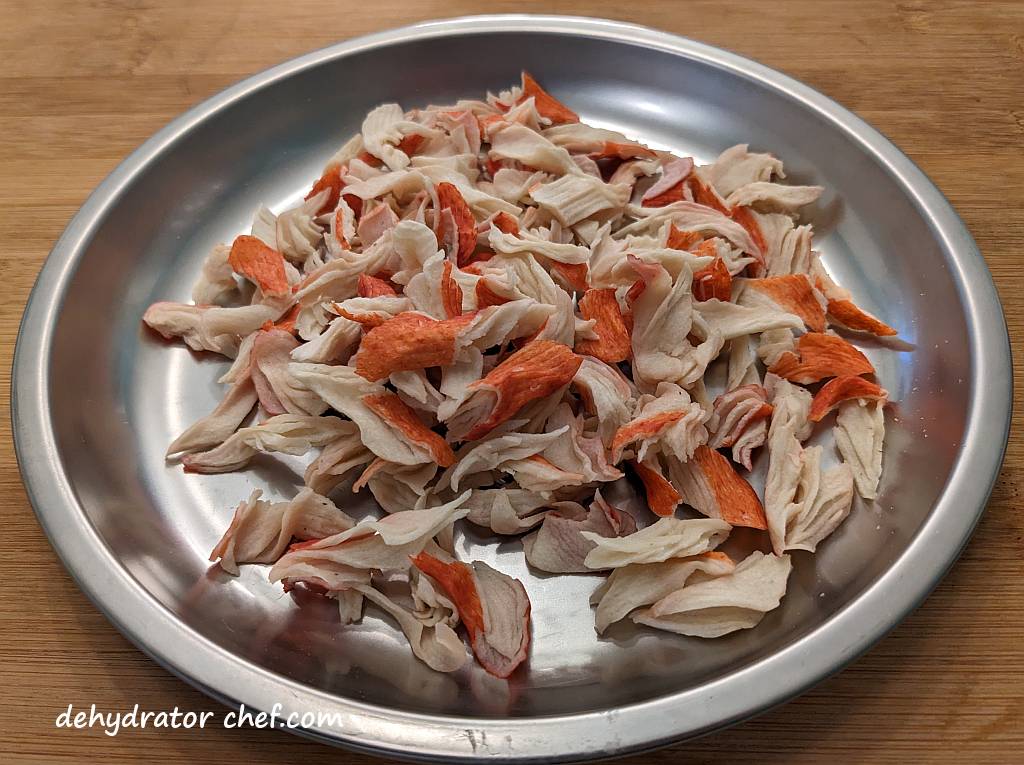
Spread the crab pieces in a single layer on the dehydrator trays lined with the mesh screen inserts. Avoid overcrowding the trays to ensure proper airflow and faster drying times. Set the dehydrator thermostat temperature to 160 °F / 71 °C and let it run for about 10 to 12 hours, depending on the ambient conditions.
After the designated time, check the dehydrated crab meat for dryness. It should feel brittle and easily snap into smaller pieces when done. If needed, allow it to dehydrate for a couple more hours. Once fully dehydrated, let the crab meat cool completely before packing it into a clean, dry, and airtight container.
To ensure equal moisture distribution and conditioning, let the dehydrated imitation crab sit in the storage container for 7 to 10 days, checking for any clumping or sticking. If mold appears, discard the entire batch. Otherwise, proceed to store the dehydrated crab meat in a cool, dry, and dark place, or optionally vacuum seal and freeze for longer-term storage.
When it comes to rehydrating the dried imitation crab meat, simply submerge it in water for at least 5 minutes, making sure it remains covered. Boiling water can speed up the process, followed by a low simmer for 1 to 2 minutes. Allow it to hydrate further by covering the pot for an additional 15 to 20 minutes. Drain any excess water, and you’ll have rehydrated imitation crab that closely resembles its fresh counterpart.
By following these steps, you can enjoy the benefits of dehydrated imitation crab meat in your culinary homemade dehydrated camping food creations. Whether you’re planning a hiking trip, a camping adventure, or preparing for unforeseen circumstances, dehydrated imitation crab meat offers convenience, longevity, and variety.
So, grab your dehydrator, and let’s get started!
Table of Contents
- How to Dehydrate Imitation Crab
- Supplies Needed for Dehydrating Imitation Crab Meat
- Step 1. Process the Imitation Crab Meat for Dehydrating
- Step 2. Preparing the Dehydrator for Dehydrating Imitation Crab Meat
- Step 3. Dehydrating Imitation Crab Meat
- Step 4. When is the Dehydrated Imitation Crab Meat Done
- Step 5. Equalizing and Conditioning of the Dehydrated Imitation Crab Meat
- Step 6. Storing Dehydrated Imitation Crab Meat
- How to Rehydrate Dried Imitation Crab Meat
- Weights, Measures, and Serving Sizes
- Insider Tips
- Conclusion
How to Dehydrate Imitation Crab
Dehydrating food at home is a useful skill to have for several reasons. Dehydrated food can last for months or even years if stored properly, making it a great option for stocking up on seasonal produce or for creating your own emergency food supply.
For today’s dehydration project, we are using imitation crab meat. Just what is imitation crab meat? Whether or not you realize it, you’ve probably eaten imitation crab before. It’s quite common in sushi that you might pick up at the grocery store and pre-packaged seafood salads.
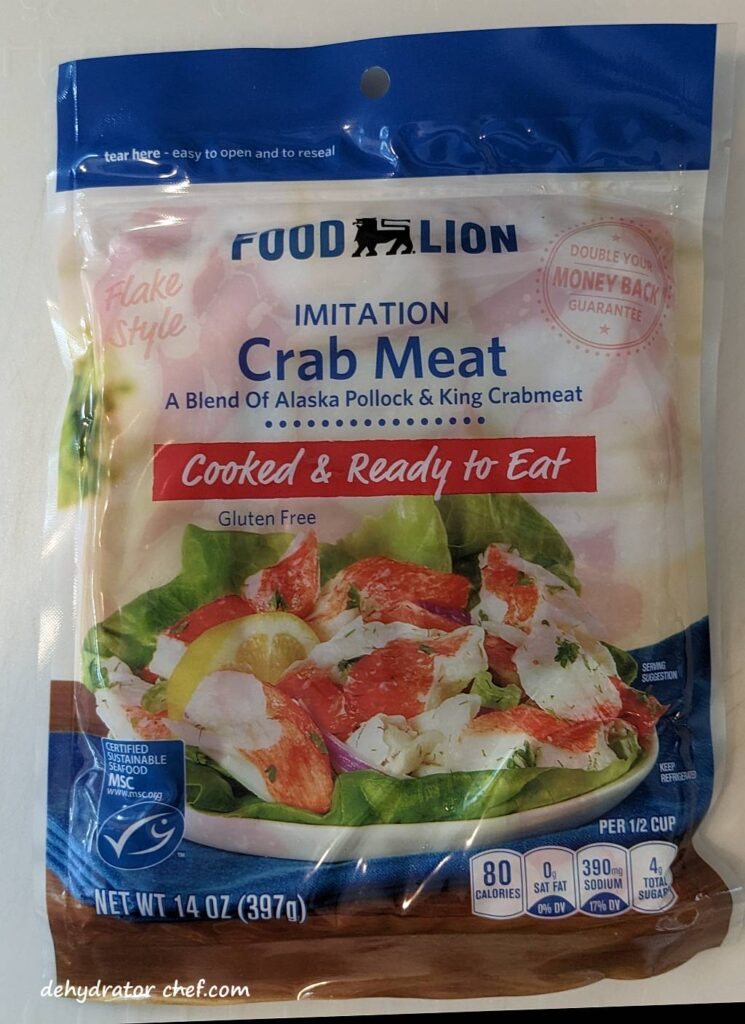
Imitation crab is actually made with real fish meat, generally not crab meat though, but check the ingredients. It’s usually made from surimi, or white fish flesh, like Alaskan Pollock, that has been deboned and minced into a paste, which is then mixed with other ingredients.
However, the imitation crab does have a nice flavor, plays well with other ingredients, dehydrates easily, and most importantly, reconstitutes quickly. A quality that the Dehydrator Chef looks for.
With the Dehydrator Chef approach, we want our homemade dehydrated camping meals to reconstitute fairly quickly when we are prepping our food using a camp stove.
Dehydrated imitation crab will last up to 4 or 5 months if properly dehydrated, conditioned, and stored under ideal pantry conditions.
You need a good quality food dehydrator. We use the Nesco FD-75A, and you can check out our food dehydrator guide here and why we think Nesco offers the best bang for the buck. We believe this is the best food dehydrator for our long-term food storage needs. Nesco has other models of food dehydrators and accessories, check them all out here.
You’ll also need the removable mesh screen inserts; one will be needed for each of the dehydrator trays.
For planning purposes, we used 3 dehydrator trays lined with removable mesh screen inserts for the 14-ounce package of imitation crab meat.
Supplies Needed for Dehydrating Imitation Crab Meat
- A package of imitation crab meat
- Common kitchen tools such as cutting boards, chef’s knife, colander, etc.
- Food dehydrator, with removable mesh screen inserts for the dehydrator trays
- Clear canning jars
- Wide-mouth canning jar funnel
- Food-safe desiccant packets
Quality canning jar prices seem to have skyrocketed overnight. Shop around for the best price on name-brand general-purpose canning jars with lids. Optionally, save, and then clean and reuse clear pint- and quart-size product jars.
We’re not reusing jar for canning purposes, we just need a clean airtight container with a good seal on the lid to protect the contents from moisture and airflow.
Step 1. Process the Imitation Crab Meat for Dehydrating
We start by opening the package and working in batches, tear the contents into small pieces. Imitation crab meat flakes just like real fish. So use that to your advantage while breaking it down into smaller and thinner pieces.
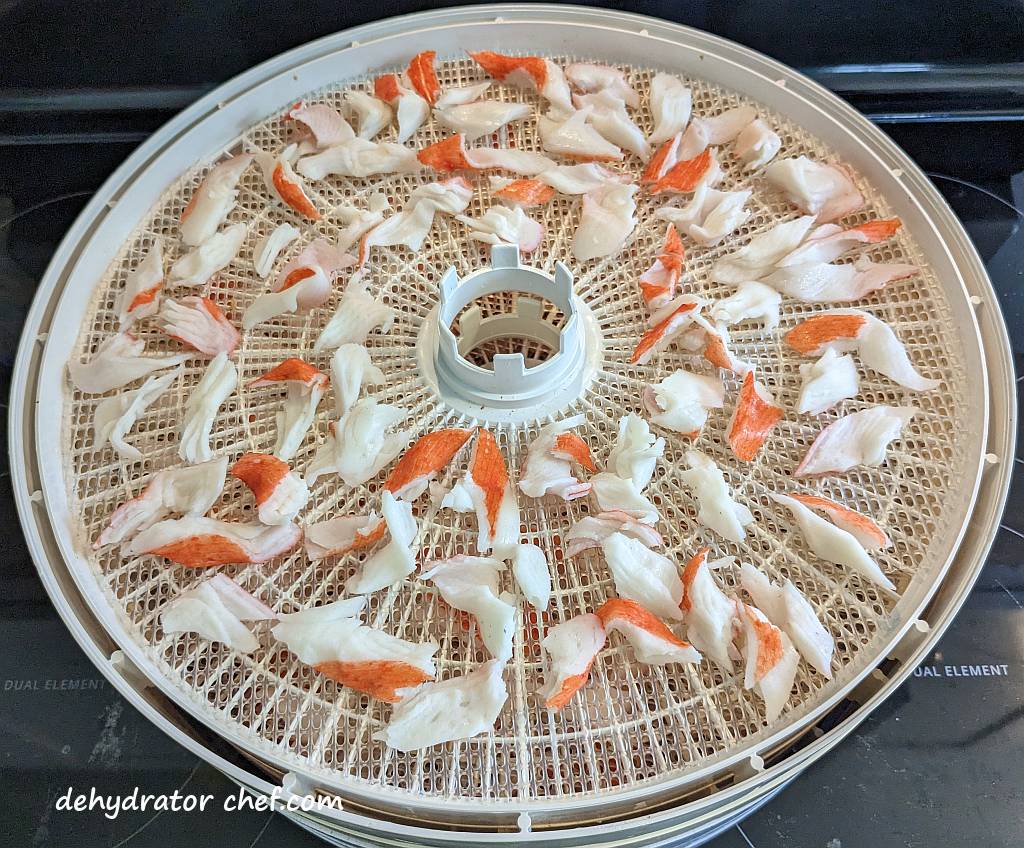
That’s it. Easy enough.
Step 2. Preparing the Dehydrator for Dehydrating Imitation Crab Meat
In a single layer, spread out the imitation crab onto the removable mesh screen inserts. Try to spread the pieces out in a single layer for faster drying times.

For best results, don’t overcrowd the dehydrator trays. Leave some space between the imitation crab pieces to allow for airflow and drying.
Nesco Clean-A-Screens are removable and flexible mesh screens that have both a distinct top and a bottom side. If you had a high-powered microscope, you would see the individual strands in mesh screens have a triangle shape. The bottom side of the screen feels smooth. The top side has the point of the triangle and feels rough as you rub your fingers across the mesh.
Step 3. Dehydrating Imitation Crab Meat
For dehydrating the imitation crab meat, set the dehydrator thermostat temperature to 160 °F / 71 °C. I find that 10 to 12 hours is about the right amount of time.

There might be a bit of a fishy smell. So you might want to dry this in the garage or outdoors, otherwise, open the windows and get a fan going.
Following the manufacturer’s guidelines is crucial for getting optimal results from your food dehydrator. These guidelines provide specific details about the product that is not available elsewhere, including assembly instructions and product specifications. Reading these guidelines in full can help ensure that the dehydrator operates as intended. Failure to follow these instructions can lead to improper assembly or operation, which can affect the quality of the food you are dehydrating.
Of course, drying times are dependent on the ambient temperature and humidity and how crowded you fill your trays. Remember to use drying times as a guide.
Step 4. When is the Dehydrated Imitation Crab Meat Done
After 10 to 12 hours, the imitation crab should be fully dehydrated. If not, let it go another 2 or 4 hours and check again.
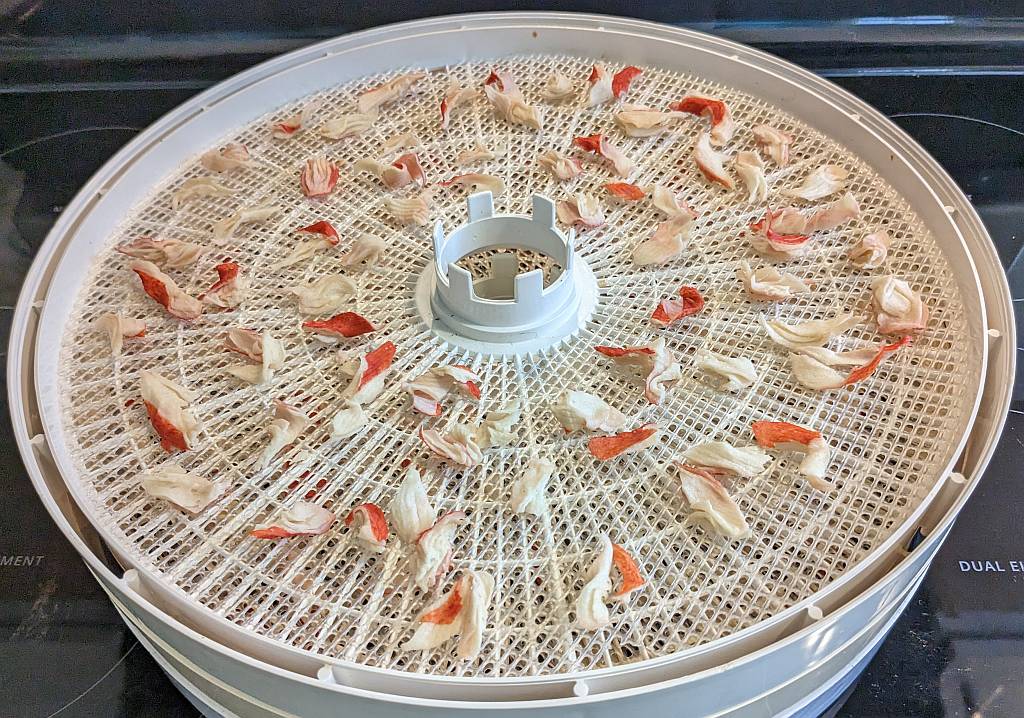
Drying times will vary depending on your dehydrator. Refer to your dehydrator owner’s manual for recommended temperatures and times for dehydrating specific foods. Remember to use drying times as a guide.
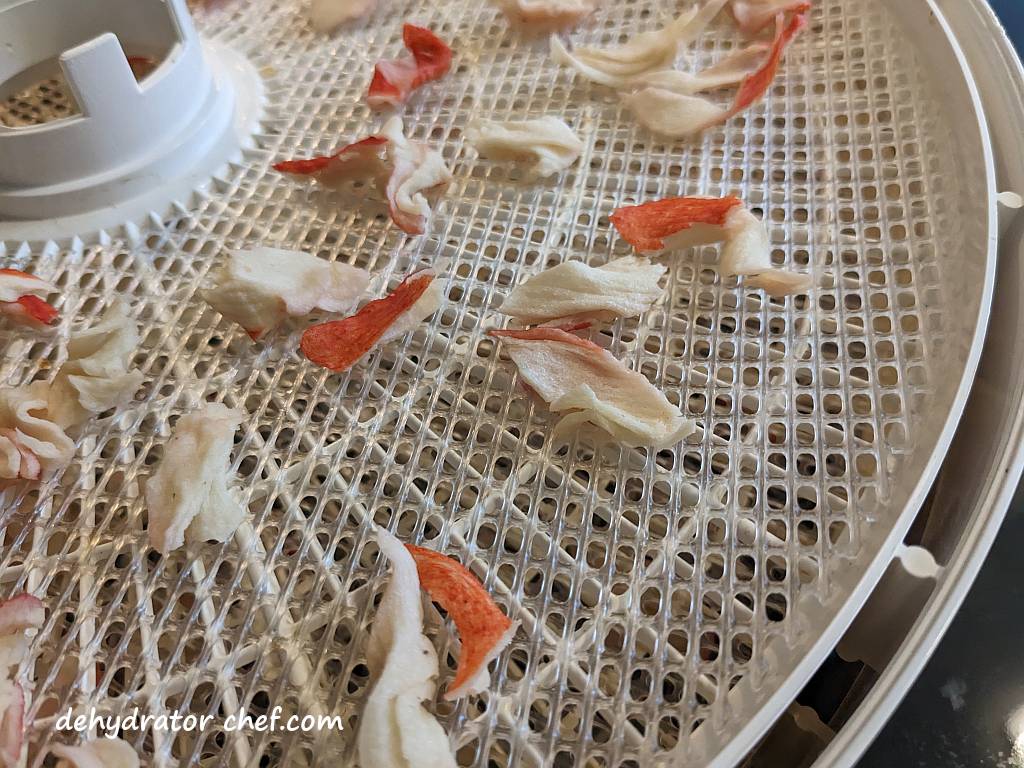
Warm imitation crab still in the food dehydrator may feel somewhat pliable, and you may believe it needs more drying time. Simply unplug the dehydrator and let everything cool down. Then check again to be sure. The dehydrated imitation crab should feel dry when finished, It is brittle and easily snaps and breaks into smaller pieces when done.
Step 5. Equalizing and Conditioning of the Dehydrated Imitation Crab Meat
When the dehydrated imitation crab is removed from the dehydrator, the remaining moisture may not be distributed equally among all of the pieces because of their location and position in the dehydrator. Equalizing and conditioning is a process for freshly dehydrated foods that ensures any residual moisture remaining in any piece is spread, or equalized, among all the other pieces in the batch. Let the dried imitation crab equalize and condition in the storage container for 7 to 10 days.
We always recommend letting food items cool completely after they have finished dehydrating and before packing them into an airtight storage container for equalizing and conditioning. Warm food may cause sweating which could provide just enough moisture for mold to grow.
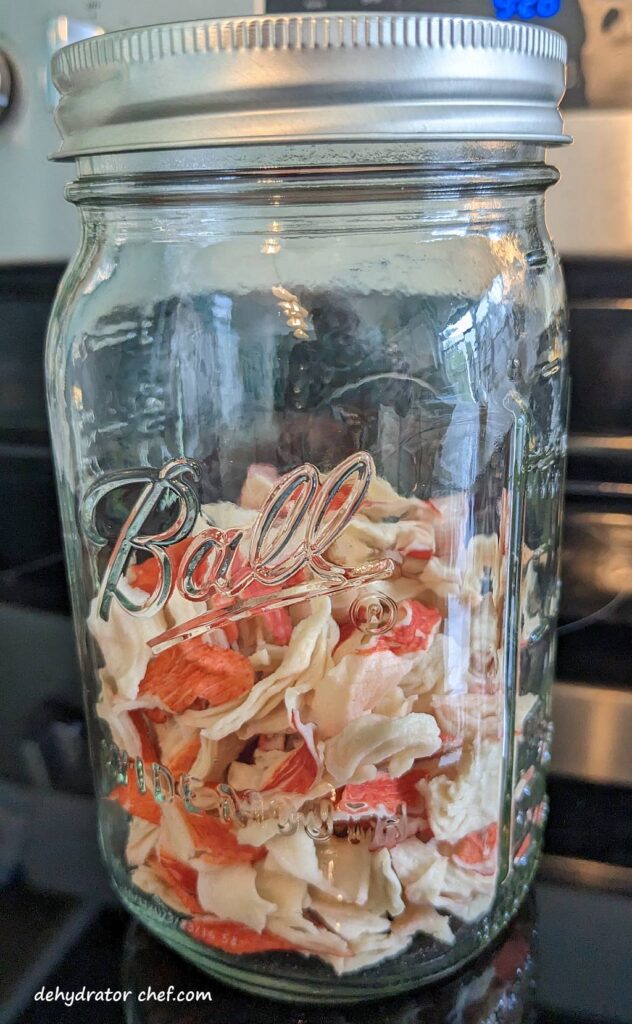
After a short cooling period, loosely pack the dehydrated imitation crab into a clean, dry, insect-proof, and air-tight storage container. We use quart-size canning jars for conditioning. Since the canning jars are clear, it’s easy to see what’s inside. Just don’t fill the jar to the top, leave some headspace.
Headspace is the distance between the food surface and the lid’s underside. Its purpose is to provide ample space for the dehydrated food product to slide and tumble when shaken and rotated to expose any evidence of clumping or sticking.
It does not take long for dehydrated food items to start hydrating from ambient household humidity. Do not leave dehydrated food items exposed to the elements any longer than necessary because of the increased risk of spoilage and mold growth.
A quality stainless steel or plastic canning funnel makes the messy job of getting dehydrated foods off the dehydrator tray removable inserts and into the canning jars an easy task. Take a minute or two and check them out here on Amazon.
Every day, check the jar for moisture. Roll the jar contents around and note any clumping or sticking. If seen, put the contents back on the dehydrator for several more hours. Since canning jars are clear, it’s easy to see what’s inside.
If you notice any mold at all, even the smallest bit, throw it all out. What you see are the mold spores finally blooming enough to make them visible. But there are more, even tinier mold spores in the rest of your jar that make your dehydrated food inedible. Toss it out, clean your gear, and start another batch.
Step 6. Storing Dehydrated Imitation Crab Meat
Dehydrated imitation crab meat will last up to 4 or 5 months if properly dehydrated, conditioned, and stored under ideal pantry conditions.
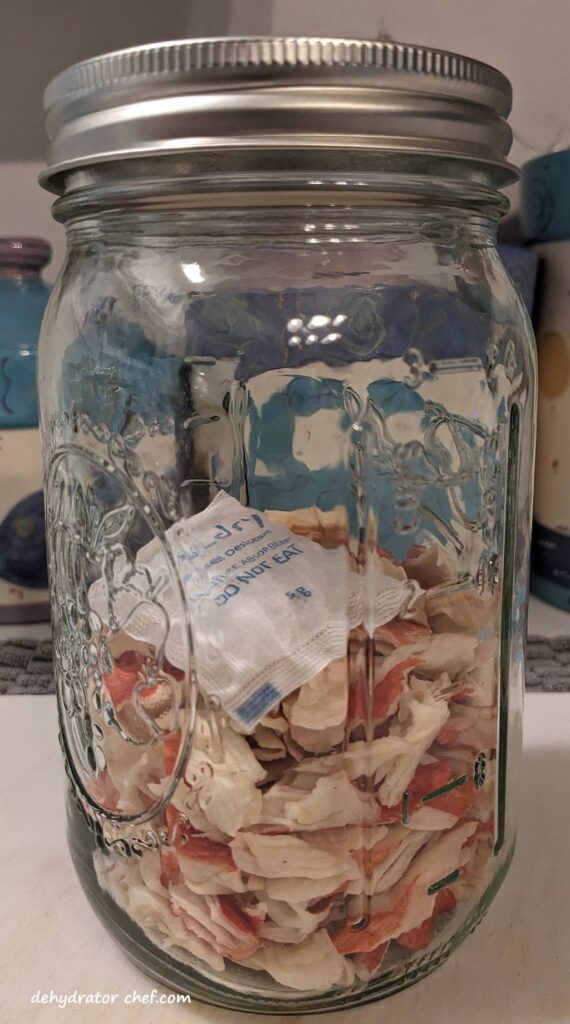
We’ll use a food-safe desiccant packet for moisture control because we live in a fairly humid area. For our pint-size or quart-size mason jars, we’ll use a single food-safe 5-gram desiccant packet. The desiccant packets will absorb any moisture and extend the shelf life of the dehydrated imitation crab meat.

We use these inexpensive food-safe desiccant packets, which are available from Amazon. These 5-gram packets have over 5000 of mostly 4- and 5-star customer reviews, with an average of 4.7 stars out of 5. Our bag of 60 desiccant packets will last quite a while because they can be recharged and reused multiple times. Other food-safe sizes are available.
We will continue to use clear canning jars with tight-fitting lids as storage containers. They are transparent, making it easy to see the contents. We’re also adding moisture-absorbing desiccant packets in Step 6. I don’t use a desiccant packet for moisture control during the equalizing and conditioning phase in Step 5. Doing so might mask moisture issues should the food items not be adequately dried.
Lastly, attach or include a short note describing the contents and the date the product was dehydrated. The note also informs us where to go in the dehydrator logbook to make another note.
How to Rehydrate Dried Imitation Crab Meat
To rehydrate dried imitation crab meat, use enough water to completely submerge and soak for at least 5 minutes in a covered pot. Periodically check to make sure the imitation crab stays covered with water as it reconstitutes.
The dehydrated imitation crab reconstitutes faster using boiled water, so now bring the mix to a boil, then turn down the heat to a low simmer for 2 minutes, stirring occasionally to prevent burning. Continue checking the water level and make sure the imitation crab remains submerged. Then remove from the heat.
Leave the cover on the cooking pot and let the mix continue to hydrate for another 15 to 20 minutes. Consider wrapping the cooking pot in a cozy to retain heat. Once fully hydrated, drain any excess water.
The rehydrated imitation crab will look almost identical to what we started with. It will also have a similar texture and taste to fresh from the package we started with.
If you’re using the dried imitation crab as part of a Dehydrator Chef recipe, just follow the recipe instructions.
Weights, Measures, and Serving Sizes
This information is a representative summary of the notes in our dehydrator logbook.
- We started with a 14-ounce / 397-gram package of imitation crab meat.
- Relevant Nutrition Facts:
- Servings about 4.5
- Serving size: 1/2 cup, 85 grams
- 397 grams / 4.5 servings = 88 grams
- Independent measurement data. The starting weight is 407 grams, which is removed from the package.
- 407 grams / 4.5 servings = 90 grams
- Going to round down to 4 servings from the package to make the math easier.
- 407 grams / 4 servings = 101.75 grams, rounded to 100 grams.
- We weighed 1/2 cup, and it was 86 grams.
- Used 2 1/2 dehydrator trays with mesh screen inserts
- Setting the dehydrator thermostat temperature to 160 °F / 71 °C. Trays on the dehydrator at 0900.
- Checked at 1915, 10 hours, and it’s done.
- The entire batch of dried imitation crab was 107 grams by weight.
- 107 grams / 4 servings = 26.75 grams per serving of dried imitation crab. Rounding to 27 grams.
Insider Tips
Store the dehydrated imitation crab meat in a cool, dry, and dark place to maximize shelf life. You can also vacuum seal and freeze them for long-term storage, 4 or 5 months to a year.
Conclusion
In conclusion, dehydrating imitation crab meat is a simple and efficient way to extend its shelf life and create a convenient ingredient for your culinary camping meal endeavors. By following the step-by-step guide outlined in this blog post, you can easily dehydrate imitation crab meat using a food dehydrator and store it for several months or even up to a year.
Dehydrated imitation crab meat offers numerous benefits, including its ability to last for extended periods when properly dehydrated, conditioned, and stored. It reconstitutes quickly, making it a valuable ingredient for camping trips or emergency food supplies. Its versatility and compatibility with various dishes make it a favorable choice for those seeking culinary options that are both convenient and flavorful.
To successfully dehydrate imitation crab meat, it is important to use a good quality food dehydrator with removable mesh screen inserts. The recommended temperature for dehydrating imitation crab meat is 160 °F / 71 °C, with a drying time of approximately 10 to 12 hours. However, it is crucial to check for dryness and brittleness before considering it fully dehydrated.
Proper storage is key to maintaining the quality of dehydrated imitation crab meat. Use clean, dry, and airtight containers such as canning jars to store the dehydrated crab. Adding a food-safe desiccant packet helps control moisture and prolongs the shelf life of the dehydrated meat. Remember to label the containers with the date of dehydration for future reference.
When it comes to rehydrating the dried imitation crab meat, it is best to submerge it in water for at least five minutes. Boiling water can expedite the rehydration process, followed by simmering for a short period. The rehydrated imitation crab will closely resemble its original texture and taste.
By mastering the art of dehydrating imitation crab meat, you can have a versatile and long-lasting ingredient at your disposal. Whether you are preparing for outdoor adventures or ensuring a stable food supply, dehydrated imitation crab meat is a valuable addition to your pantry. So grab your food dehydrator, follow the steps provided, and enjoy the benefits of dehydrated imitation crab meat in your culinary creations.
